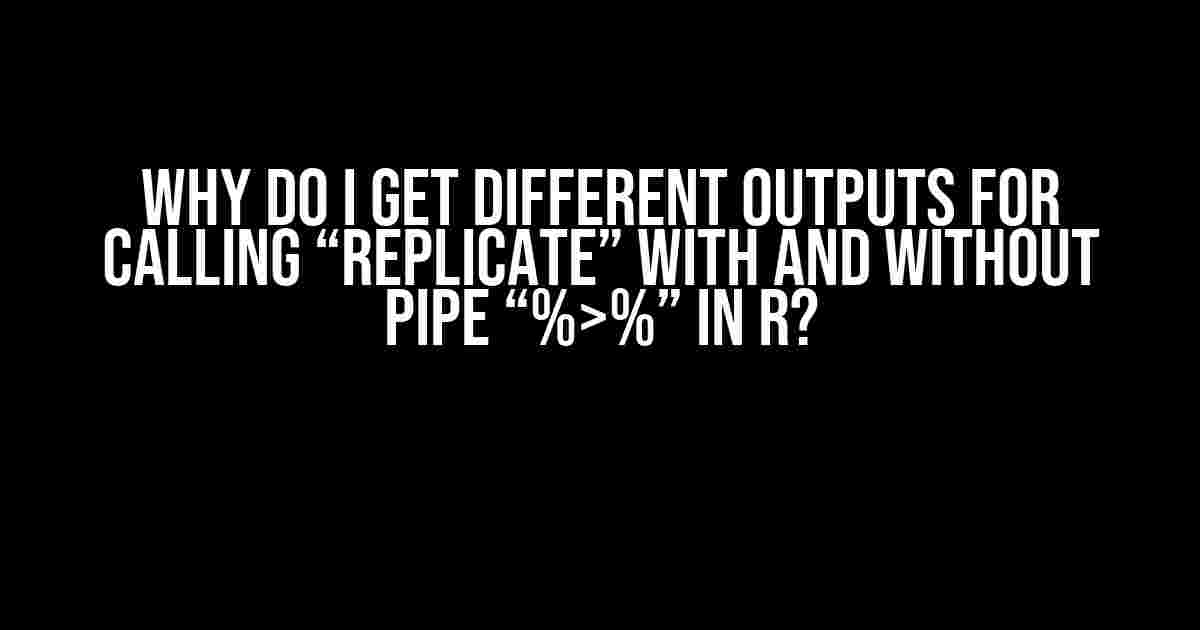If you’re new to R, you might have stumbled upon the `replicate` function and wondered why it behaves differently when used with and without the pipe operator `%>%`. In this article, we’ll dive into the world of R and explore the magic behind `replicate` and the pipe operator, and provide clear explanations and examples to help you master them.
What is the `replicate` function?
The `replicate` function in R is used to repeat an expression or a function call multiple times. It’s often used to generate multiple versions of a dataset, perform simulation studies, or simply to repeat a task multiple times. The basic syntax of `replicate` is:
replicate(n, expr, simplify = "array")
Where:
- `n` is the number of times to replicate the expression
- `expr` is the expression or function to be replicated
- `simplify` is a logical value indicating whether to simplify the output to an array or a list
What is the pipe operator `%>%`?
The pipe operator `%>%` is a part of the `magrittr` package in R and is used to pass the output of one expression as the input to another expression. The pipe operator is often referred to as the “forward pipe” or “chaining operator”. The basic syntax of the pipe operator is:
expression %>% function
Where `expression` is the output that is passed to the `function` as an input.
Why does `replicate` behave differently with and without the pipe operator?
When you use `replicate` without the pipe operator, the output is a vector or a matrix, depending on the `simplify` argument. For example:
replicate(3, rnorm(10), simplify = FALSE)
This code will generate 3 lists, each containing 10 random numbers from a normal distribution.
However, when you use `replicate` with the pipe operator, the output is a list of lists, regardless of the `simplify` argument. For example:
replicate(3, rnorm(10)) %>% list()
This code will generate a list of 3 lists, each containing 10 random numbers from a normal distribution.
So, why does this happen?
The Reason Behind the Difference
The reason behind this difference lies in how R interprets the expressions. When you use `replicate` without the pipe operator, R evaluates the expression inside `replicate` and returns the result as a vector or a matrix.
However, when you use `replicate` with the pipe operator, R evaluates the expression inside `replicate` and passes the result as an input to the `list()` function. This creates a new list containing the output of `replicate` as a single element.
To illustrate this, let’s take a closer look at the intermediate output:
replicate(3, rnorm(10)) -> temp temp %>% str()
This code will show you the intermediate output of `replicate`, which is a vector of 30 random numbers. When you pipe this output to `list()`, R creates a new list containing this vector as a single element.
How to Get Consistent Output?
To get consistent output, you can use the `simplify` argument of `replicate` to control the output format. For example:
replicate(3, rnorm(10), simplify = TRUE)
This code will generate a matrix with 3 rows and 10 columns, containing the replicated output.
Alternatively, you can use the `unlist()` function to flatten the output of `replicate` when used with the pipe operator:
replicate(3, rnorm(10)) %>% unlist() %>% matrix(ncol = 10)
This code will generate a matrix with 3 rows and 10 columns, containing the replicated output.
Best Practices for Using `replicate` and the Pipe Operator
Here are some best practices to keep in mind when using `replicate` and the pipe operator:
- Use `simplify = TRUE` when you want to generate a matrix or a vector as output.
- Use `simplify = FALSE` when you want to generate a list of lists as output.
- Use the pipe operator when you want to pass the output of `replicate` to another function.
- Use `unlist()` to flatten the output of `replicate` when used with the pipe operator.
- Check the intermediate output using `str()` to ensure you’re getting the desired format.
Conclusion
In conclusion, the `replicate` function and the pipe operator `%>%` are powerful tools in R, but they can behave differently depending on how they’re used. By understanding the underlying mechanics and following best practices, you can get consistent output and master the art of data manipulation in R. Remember to use `simplify` to control the output format, and `unlist()` to flatten the output when needed. Happy coding!
| Function | Purpose | Example |
|---|---|---|
| `replicate` | Repeat an expression or function call multiple times | replicate(3, rnorm(10)) |
| `%>%` | Pass the output of one expression as the input to another expression | replicate(3, rnorm(10)) %>% list() |
| `simplify` | Control the output format of `replicate` (vector, matrix, or list) | replicate(3, rnorm(10), simplify = TRUE) |
| `unlist` | Flatten a list of lists into a single vector | replicate(3, rnorm(10)) %>% unlist() %>% matrix(ncol = 10) |
References:
- R Documentation: `replicate` function
- R Documentation: `magrittr` package
- Stack Overflow: “Why does `replicate` behave differently with and without pipe operator?”
By following this article, you should now have a deep understanding of how `replicate` and the pipe operator work together in R. Remember to practice and experiment with different scenarios to solidify your knowledge. Happy coding!
Frequently Asked Question
Ever wondered why you get different outputs when calling “replicate” with and without the pipe “%>%” in R? Let’s dive into the answers!
Q1: What is the purpose of the pipe “%>%” in R?
The pipe “%>%” is an operator in R that allows you to pass the output of one function as the input to another function, making your code more readable and efficient. It’s similar to using the output of one function as an argument to another function, but in a more concise way.
Q2: How does the “replicate” function work in R?
The “replicate” function in R is used to repeat an expression or a function call multiple times. It’s often used to simulate data or to perform bootstrapping. When you call “replicate” without the pipe “%>%”, it returns a vector or matrix with the repeated values.
Q3: What happens when I use “replicate” with the pipe “%>%” in R?
When you use “replicate” with the pipe “%>%”, it applies the function or expression on the left side of the pipe to each element of the output of the “replicate” function. This can lead to different results compared to calling “replicate” without the pipe, especially when working with complex expressions or functions.
Q4: Why do I get different outputs when calling “replicate” with and without the pipe “%>%” in R?
The difference in output is due to how the pipe operator works. Without the pipe, “replicate” returns a vector or matrix with the repeated values. With the pipe, “replicate” returns an output that is then passed to the next function or expression, which can lead to different results. It’s essential to understand the context and the functions being used to anticipate the output.
Q5: How can I ensure consistency in my output when using “replicate” with and without the pipe “%>%” in R?
To ensure consistency, carefully examine the functions and expressions being used with “replicate” and consider the context in which they are being applied. If you’re unsure, break down the code into smaller parts and inspect the intermediate outputs to understand how the pipe operator is affecting the results.



